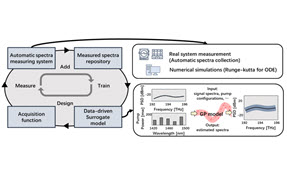Novel cathode structure for light-emitting diodes
An insulated polymer introduced between the metal cathode and light emissive layer of typical organic/polymer light-emitting diodes (O/PLEDs) might be expected to increase series resistance, reduce injected current, and raise the turn-on voltage of electroluminescence (EL). However, when the thickness of the insulated film is just a few (2–5) nanometers, the interfacial layer becomes a “magic buffer medium”1–3 that enables efficient injection of electrons through the aluminum cathode into the organic/polymer light-emissive layer.
Our recent work successfully demonstrates that the luminous efficiency (measured in cd/A) of PLEDs applying the organic oxide/Al cathode structure, is enhanced by two orders of magnitude as compared to that of the Al-cathode device.4,5 We note that Al is a high-work-function metal with a large injection barrier height for electrons.
The configuration of the PLED that incorporates the organic oxide/Al cathode structure is presented in Figure 1. The device is comprised of a glass substrate topped by an indium-tin-oxide (ITO) anode, a polymer hole-transport layer, a “high-yellow” copolymer light-emitting film,6 and a 2.5nm thick poly(ethylene glycol) dimethyl ether (PEGDE) film as the interface buffer layer, and the Al metal cathode electrode. The organic-oxide film was prepared by thermally evaporating a PEGDE layer onto the surface of the light-emitting phenyl-substituted poly(para-phenylene vinylene) copolymer (HY-PPV) film inside a vacuum chamber (10−6T). The Al electrode was then evaporated on the substrates without breaking the vacuum. This process enables sensitive control of thickness and the functional groups of the cathode buffer layer, and also avoids concerns about solvent compatibilities with organic layers while constructing the multi-layer structure of O/PLEDs.


Figure 2(a) presents the current-brightness-voltage (I-L-V) curves for devices of the HY-PPV-based PLEDs, with EL emission centered at 560nm and applying Al and PEGDE(2.5nm)/Al as the cathode. Without the PEGDE layer the device shows low EL intensity and poor luminous efficiency of 374cd/m2 and 0.11cd/A, respectively, when the device is biased at 8.50V. The low EL can be attributed to the inefficient injection of electrons due to the large injection barrier height between the work function of Al and the lowest unoccupied molecular orbital level of HY-PPV. However, when an additional 2.5nm PEGDE layer is placed at the cathode interface, EL intensity improves to over 42,000cd/m2 biased at 8.50V for the device. The light turn-on voltage is reduced to 2.50V, instead of 3.80V for the device using only Al. Maximum luminous efficiency of 8.86cd/A is found at 4493.1cd/m2 as shown in Figure 2(b). Device performance improves with the formation of a specific organic oxide/Al complex at the cathode interface during the deposition of Al, facilitating the injection of electrons and eliminating the metal-induced quenching sites of luminescence in the EL layer near the recombination region.5 Figure 3 presents a photograph of the HY-PPV device fabricated with a PEGDE(2.5 nm)/Al cathode. Uniformity of EL across the light-emissive region was excellent, as determined by microscopy.
Performance varies with the thickness of the organic-oxide buffer layers. The luminous efficiencies of the PEGDE/Al devices with PEGDE layers of thicknesses 1.2, 2.5, 5.0, and 7.5nm, biased at 100mA/cm,2 are 7.15, 8.74, 5.89, and 4.11cd/A, respectively. The region in which Al atoms effectively react with the organic-oxide layer is limited to the contact interface of several nanometers. Best performance comes with a 2.5nm-thick PEGDE/Al cathode. EL efficiency declines as the thickness of the organic-oxide layers increases, because the PEGDE film is basically an insulating polymer.
In summary, we have offered a method for fabricating high-performance PLEDs based on an organic-oxide buffer layer with Al as the device cathode, in which the steps for preparing a salt-free neutral interfacial layer can be easily integrated into the manufacturing process for polymer light-emissive devices. Further information about application of the novel organic oxide/Al cathode structure to the high performance small molecule OLEDs and top-emissive PLEDs can be found in our recent publications. 7,8
Tzung-Fang Guo is associate professor at the Institute of Electro-Optical Science & Engineering, Advanced Optoelectronic Technology Center, National Cheng Kung University, Tainan, Taiwan.




